Straw Biochar and Graphite Oxide Enhanced External Pressure Ultrafiltration for Leaded Wastewater Treatment
Abstract
1. Introduction
2. Materials and Methods
2.1. Materials and Reagents
2.2. Preparation of SB/GO
2.3. Equipments and Methods
3. Results and Discussion
3.1. FT-IR Spectra of Samples
3.2. Optimizing Operation Parameters
3.3. Removal Performance Comparation
3.3.1. CODCr Removal
3.3.2. NH3-N Removal
3.3.3. Turbidity Removal
3.3.4. Pb2+ Removal
3.4. Membrane Contamination and Cleaning
4. Conclusions
- (1)
- When the pH and temperature of polluted water were set at 4.8–5.2 and 21–30 °C, respectively, the SGU process had the best removal effect on CODCr and NH3-N.
- (2)
- The introduction of SB and GO has a significant effect on the improvement in effluent quality. The average removal rates of CODCr, NH3-N, turbidity, and Pb2+ by the combined GO-MBR process were 91%, 97%, 98%, and 95%, respectively, which were higher than SU, UF, and CT. The water quality is better than the quality standard of the domestic miscellaneous water of the Ministry of Construction of China (CJ25.1-89).
- (3)
- The weak alkali backwashing method can restore the membrane flux to 89% of the new membrane, so the system should use weak alkali washing.
Author Contributions
Funding
Institutional Review Board Statement
Informed Consent Statement
Data Availability Statement
Acknowledgments
Conflicts of Interest
References
- Qiao, J.Y.; Tang, J.; Xue, Q. Study on Pb release by several new lixiviants in weathered crust elution-deposited rare earth ore leaching process: Behavior and mechanism. Ecotoxicol. Environ. Saf. 2020, 190, 110138. [Google Scholar] [CrossRef] [PubMed]
- Zheng, T.H.; Yang, J.; Huang, P.F.; Tang, C.J.; Wan, J.L. Comparison of trace element pollution, sequential extraction, and risk level in different depths of tailings with different accumulation age from a rare earth mine in Jiangxi Province, China. J. Soil. Sediment. 2018, 18, 992–1002. [Google Scholar] [CrossRef]
- Li, Y.Z.; He, Y.L.; Liu, Y.H.; Yang, S.C.; Zhang, G.J. Comparison of the filtration characteristics between biological powdered activated carbon sludge and activated sludge in submerged membrane bioreactors. Desalination 2005, 174, 305–314. [Google Scholar] [CrossRef]
- Chen, Z.; Osman, A.I.; Rooney, D.W.; Oh, W.D.; Yap, P.-S. Remediation of Heavy Metals in Polluted Water by Immobilized Algae: Current Applications and Future Perspectives. Sustainability 2023, 15, 5128. [Google Scholar] [CrossRef]
- Aguiar, T.; Baumann, L.; Albuquerque, A.; Teixeira, L.; de Souza Gil, E.; Scalize, P. Application of Electrocoagulation for the Removal of Transition Metals in Water. Sustainability 2023, 15, 1492. [Google Scholar] [CrossRef]
- Zhao, L.; Nan, H.; Kan, Y.; Xu, X.Y.; Qiu, H.; Cao, X.D. Infiltration behavior of heavy metals in runoff through soil amended with biochar as bulking agent. Environ. Pollut. 2019, 254, 113114. [Google Scholar] [CrossRef] [PubMed]
- Liu, H.L.; Xu, F.; Xie, Y.L.; Wang, C.; Zhang, A.K.; Li, L.L.; Xu, H. Effect of modified coconut shell biochar on availability of heavy metals and biochemical characteristics of soil in multiple heavy metals contaminated soil. Sci. Total Environ. 2018, 645, 702–709. [Google Scholar] [CrossRef] [PubMed]
- Wang, B.; Gao, B.; Fang, J. Recent advances in engineered biochar productions and applications. Crit. Rev. Environ. Sci. Technol. 2017, 47, 2158–2207. [Google Scholar] [CrossRef]
- Liang, Y.H.; Xu, X.J.; Yuan, F.Z.; Lin, Y.L.; Xu, Y.S.; Zhang, Y.Y.; Chen, D.C.; Wang, W.Y.; Hu, H.W.; Ou, J.Z. Graphene oxide additive-driven widening of microporous biochar for promoting water pollutant capturing. Carbon 2023, 205, 40–53. [Google Scholar] [CrossRef]
- Gu, H.; Gao, Y.Q.; Xiong, M.M.; Zhang, D.F.; Chen, W.F.; Xu, Z.H. Removal of nitrobenzene from aqueous solution by graphene/biochar supported nanoscale zero-valent-iron: Reduction enhancement behavior and mechanism. Sep. Purif. Technol. 2021, 275, 119146. [Google Scholar] [CrossRef]
- Gao, Y.R.; Fang, Z.; Lin, W.H.; Chen, H.B.; Bhatnagar, A.; Li, J.H.; Xie, Y.H.; Bao, Y.P.; Chen, J.F.; Zhao, H.T.; et al. Large-flake graphene-modified biochar for the removal of bisphenol S from water: Rapid oxygen escape mechanism for synthesis and improved adsorption performance. Environ. Pollut. 2023, 317, 120847. [Google Scholar] [CrossRef] [PubMed]
- Xiong, S.Y.; Wu, Z.J.; Li, Z.L. Facile fabrication of robust, versatile, and recyclable biochar-graphene oxide composite monoliths for efficient removal of different contaminants in water. Chemosphere 2022, 287, 132418. [Google Scholar] [CrossRef] [PubMed]
- Wang, L.; Wang, Y.; Ma, F.; Tankpa, V.; Bai, S.S.; Guo, X.M.; Wang, X. Mechanisms and reutilization of modified biochar used for removal of heavy metals from wastewater: A review. Sci. Total Environ. 2019, 668, 1298–1309. [Google Scholar] [CrossRef] [PubMed]
- Zhang, S.; Yu, Y.; Wang, D.H.; Wang, W.; Zhang, H.G.; Cen, K. The speciation and distribution characteristics and ecological risk assessment of heavy metals in soils of ion-absorbed rare earth mining areas in southern Jiangxi. Rock Miner. Anal. 2020, 39, 726–738. [Google Scholar] [CrossRef]
- Liu, Z.W.; Lu, C.B.; Yang, S.; Zeng, J.F.; Yin, S.Y. Release characteristics of manganese in soil under ion-absorbed rare earth mining conditions. Soil. Sediment Contam. 2020, 29, 703–720. [Google Scholar] [CrossRef]
- Xu, Y.Y.; Liu, Y.C.; Zang, J.; Chen, M.; Liu, Z.F.; Li, R.X.; Turkhon, J. Spatial distribution characteristics and risk assessment of three nitrogen and heavy metals in typical river basins in the upper reaches of Ganjiang River. Earth Environ. 2020, 48, 547–583. [Google Scholar] [CrossRef]
- Wang, X.L.; Peng, Y.Z.; Wang, B.Z.; Wang, S.Y. Experimental study of PAC-UF combined system in drinking water treatment. Technol. Water Treat. 2005, 31, 56–60. [Google Scholar] [CrossRef]
- Bae, T.H.; Tak, T.M. Interpretation of fouling characteristics of ultrafiltration membranes during the filtration of membrane bioreactor missed liquor. Mem. Sci. 2005, 264, 151–160. [Google Scholar] [CrossRef]
- Pei, L.; Xiao, J.A.; Ma, L.; Sun, L.Y.; Wang, C.H.; Wang, L.M. Effects of different particle sizes of the substrate in the stepped wetland on the purification of agricultural domestic wastewater. Technol. Water Treat. 2022, 48, 114–118. [Google Scholar] [CrossRef]
- Pei, L.; Liao, X.Y.; Ma, D. Extraction effect of combined liquid membrane on arsenic (As) in soil leaching solution. Environ. Chem. 2018, 37, 2002–2007. [Google Scholar] [CrossRef]
- Ma, W.Y.; Xu, Y.M.; Zhou, D.M.; Wang, L.; Liang, X.F.; Sun, Y.B. Development and optimization of high–performance nano–biochar for efficient removal Cd in aqueous: Absorption performance and interaction mechanisms. Chem. Eng. Res. Desi. 2023, 189, 516–529. [Google Scholar] [CrossRef]
- Zhang, Y.; Cao, B.; Zhao, L.L.; Sun, L.L.; Gao, Y.; Li, J.J.; Yang, F. Biochar-supported reduced graphene oxide composite for adsorption and coadsorption of atrazine and lead ions. Appl. Sur. Sci. 2018, 427, 147–155. [Google Scholar] [CrossRef]
- Carneiro, J.S.D.; Leite, D.A.D.; de Castro, G.M.; Franca, J.R.; Botelho, L.; Soares, J.R.; de Oliveira, J.E.; Melo, L.C.A. Biochar-graphene oxide composite is efficient to adsorb and deliver copper and zinc in tropical soil. J. Clean. Prod. 2022, 360, 132170. [Google Scholar] [CrossRef]
- Chemtai, C.; Ngigi, A.N.; Kengara, F.O. Ciprofloxacin sorption by non-activated and activated biochar derived from millet husks and water hyacinth. Sustain. Chem. Environ. 2024, 5, 100075. [Google Scholar] [CrossRef]
- Zhou, R.F.; Yang, S.Y.; Tao, E.; Xiao, X.Y.; Liu, L.; Li, Y. Mild-method synthesized GO-TiO2 retains oxygen-containing functional groups as an effective adsorbent. J. Solid State Chem. 2021, 301, 122290. [Google Scholar] [CrossRef]
- Kim, H.B.; Kim, J.G.; Alessi, D.S.; Baek, K. Temporal changes in the mobility of As, Pb, Zn, and Cu due to differences in biochar stability caused by lignin content. Chem. Eng. J. 2024, 493, 152567. [Google Scholar] [CrossRef]
- Zhang, X.; Fang, C.Q.; Cheng, Y.L.; Li, M.Y.; Liu, J. Fine extraction of cellulose from corn straw and the application for eco-friendly packaging films enhanced with polyvinyl alcohol. Int. J. Biol. Macromol. 2024, 268, 131984. [Google Scholar] [CrossRef]
- Ighalo, J.O.; Rangabhashiyam, S.; Dultad, K.; Umeh, C.T.; Iwuozor, K.O.; Aniagor, C.O.; Eshiemogie, S.O.; Iwuchukwu, F.U.; Igwegbe, C.A. Recent advances in hydrochar application for the adsorptive removal of wastewater pollutants. Chem. Eng. Res. Des. 2022, 184, 419–445. [Google Scholar] [CrossRef]
- Wu, J.; Yang, J.W.; Feng, P.; Huang, G.H.; Xu, C.H.; Lin, B.F. High-efficiency removal of dyes from wastewater by fully recycling litchi peel biochar. Chemosphere 2020, 246, 125734. [Google Scholar] [CrossRef] [PubMed]
- Pei, L.; Yao, B.H. PAC-MBR combined process for urban sewage treatment. Environ. Eng. 2008, 26, 7–9. [Google Scholar]

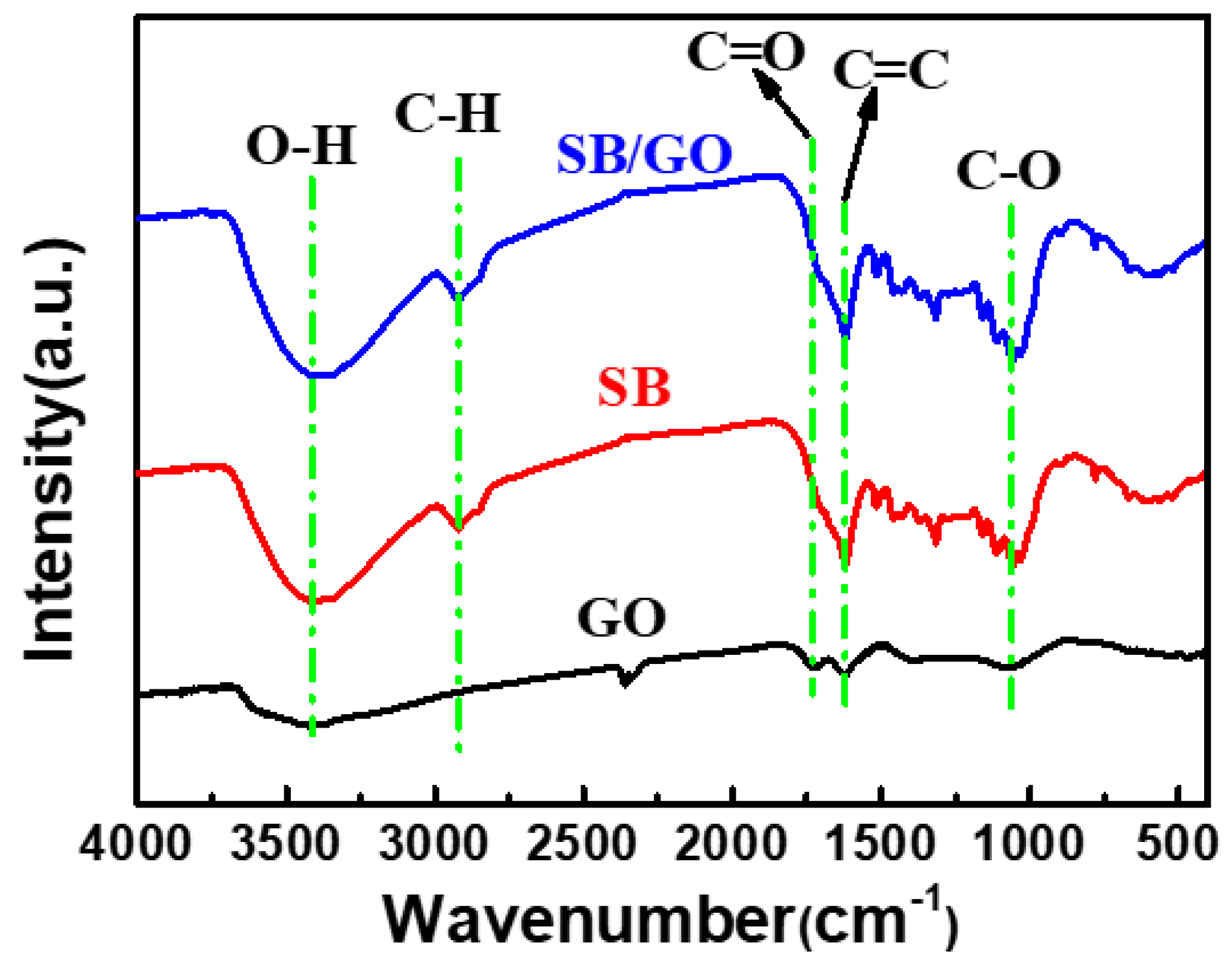
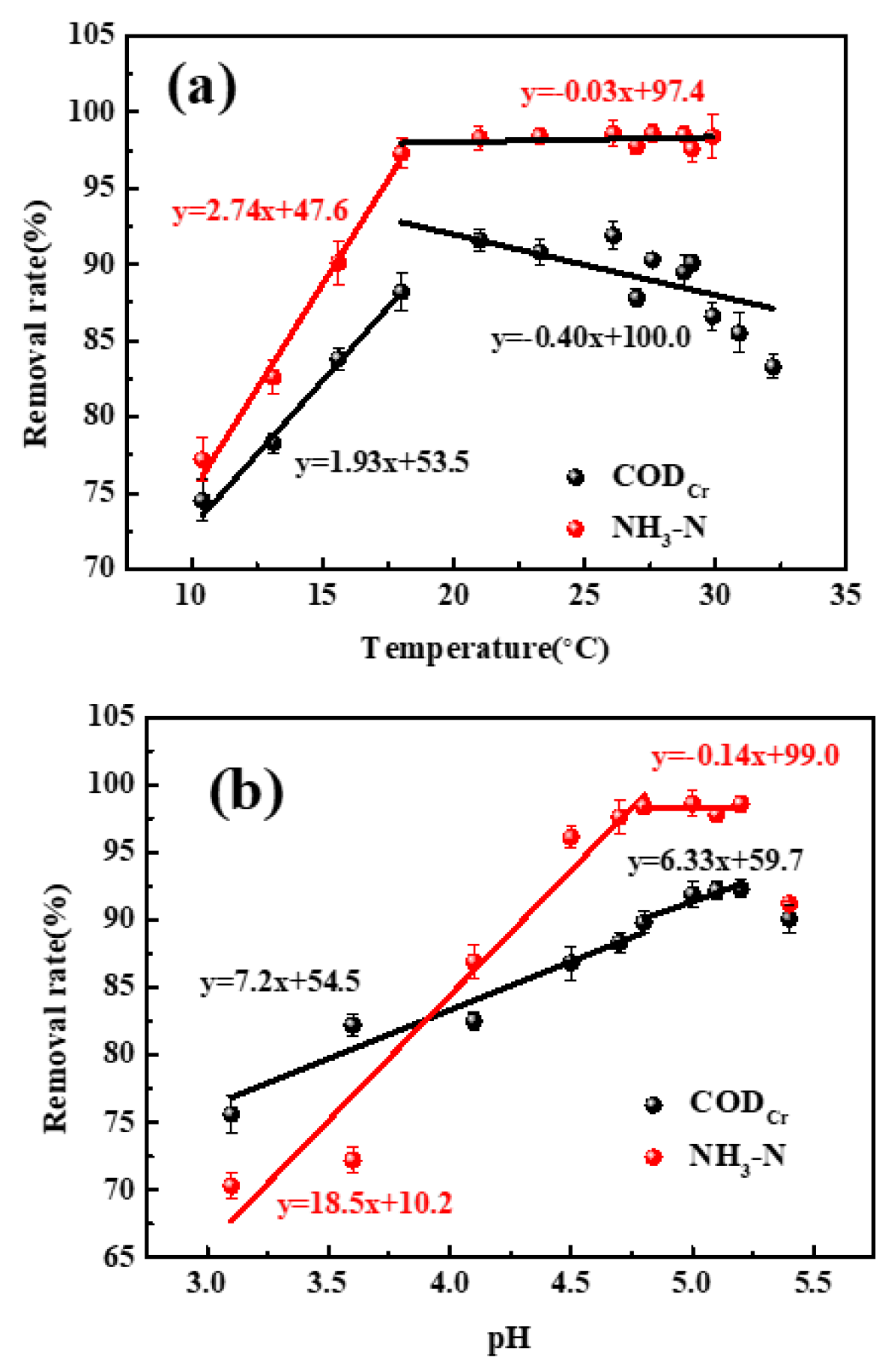
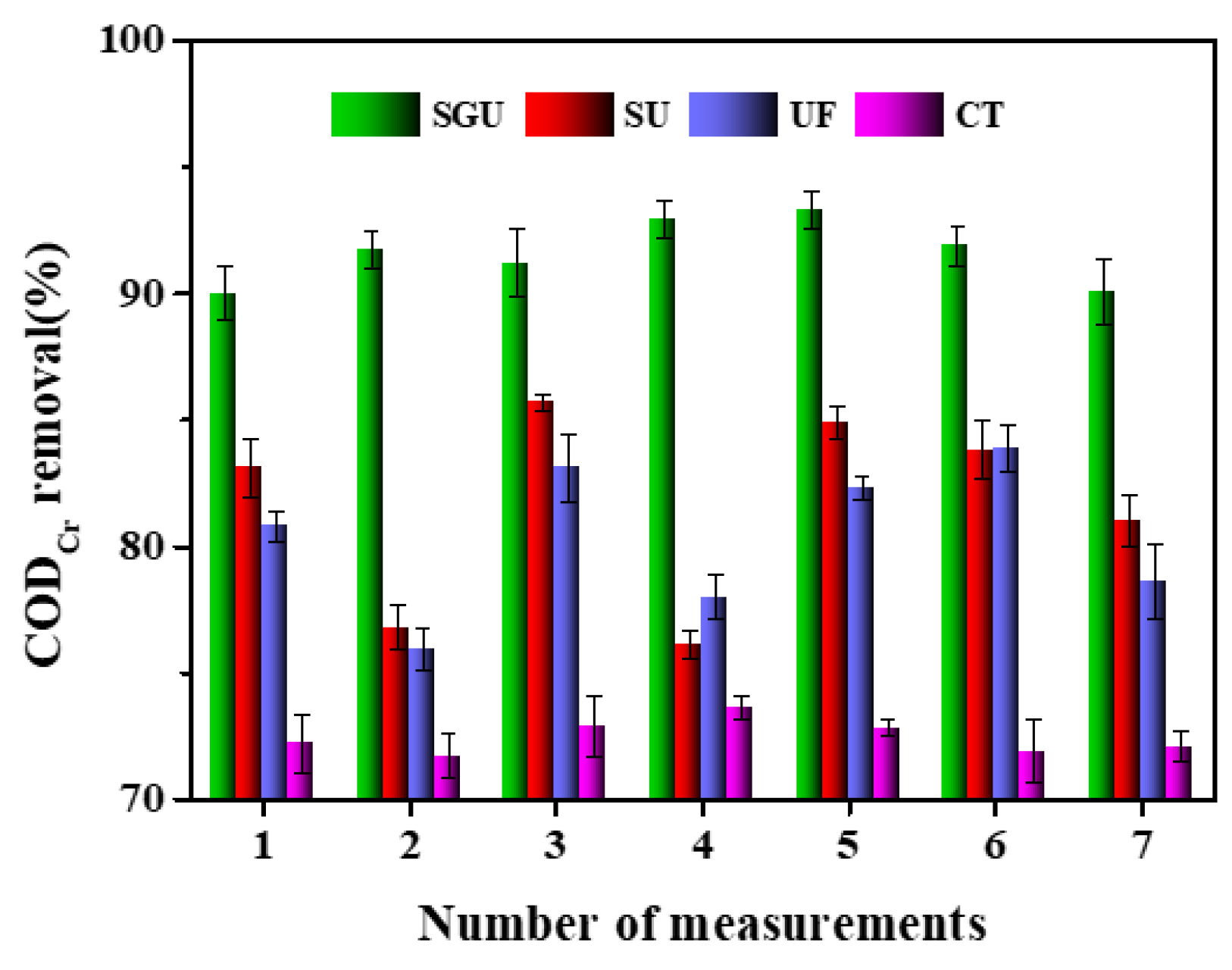
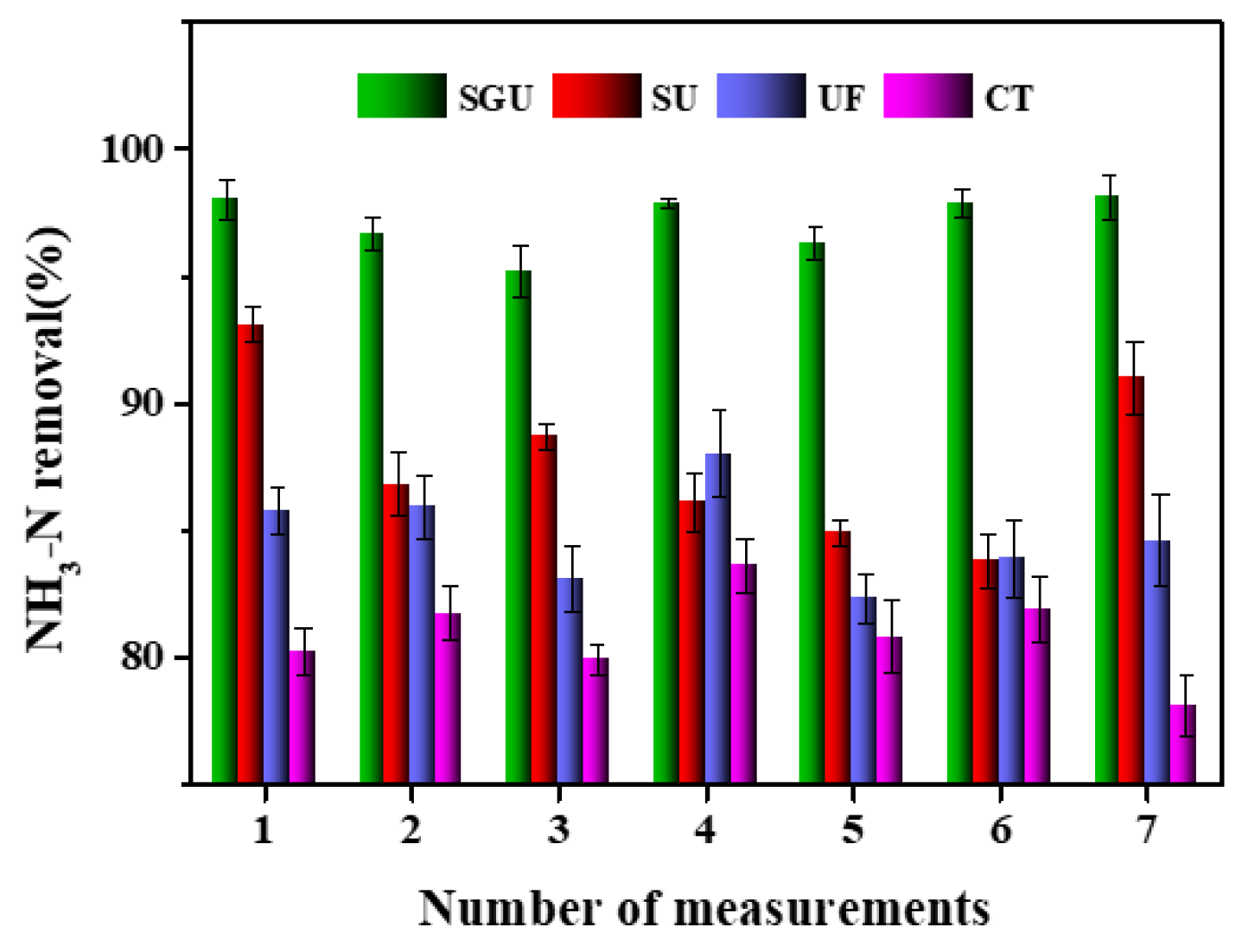
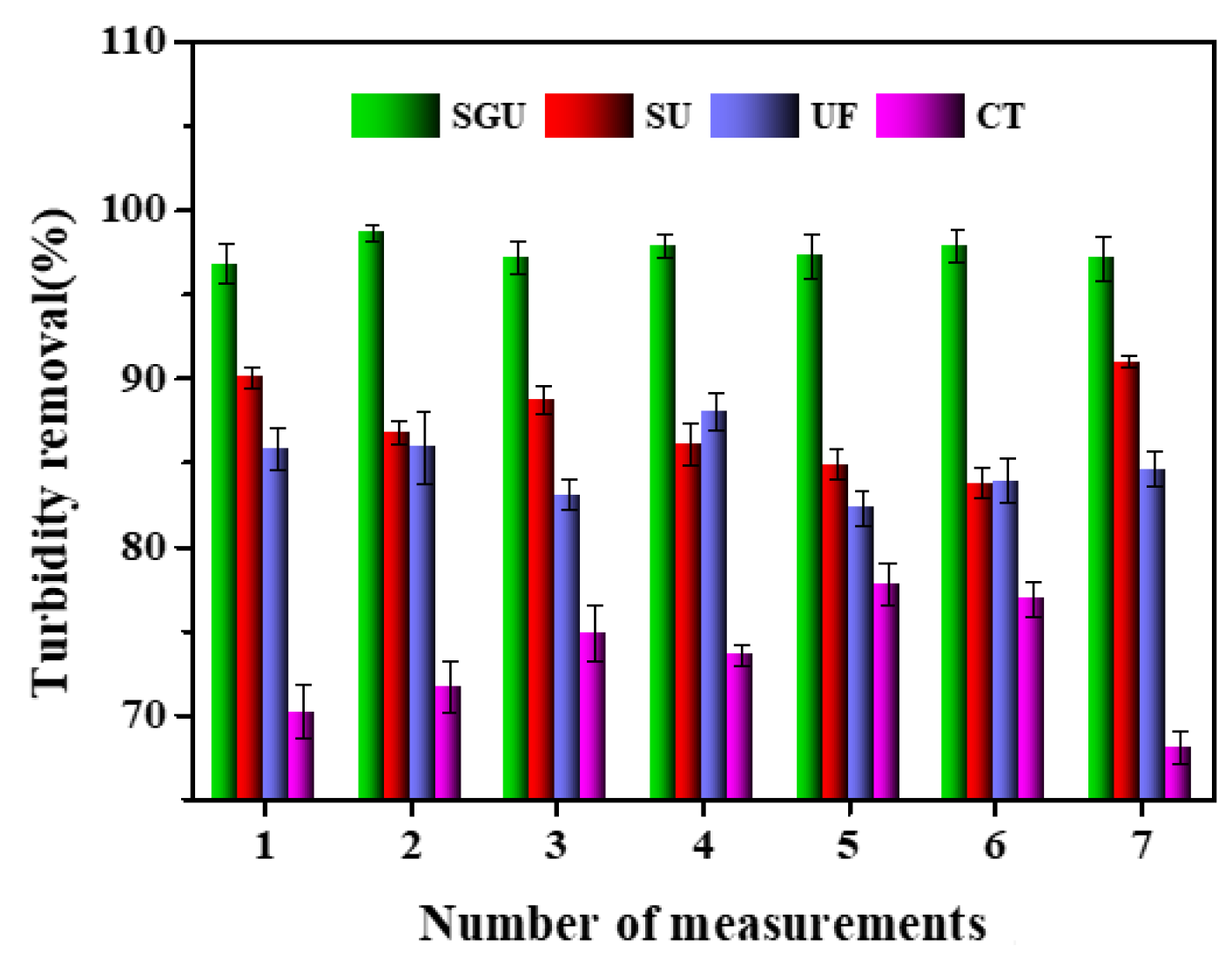
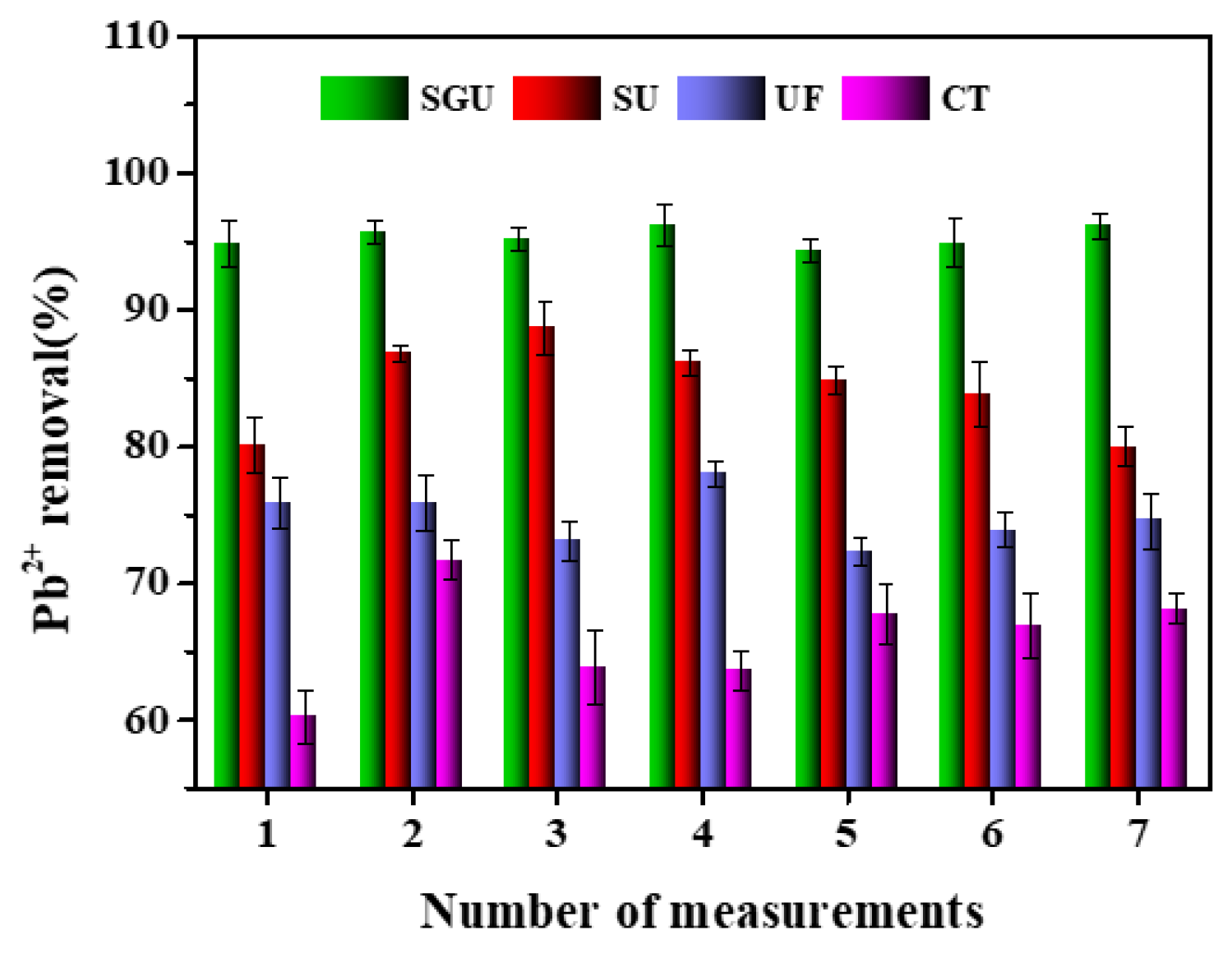
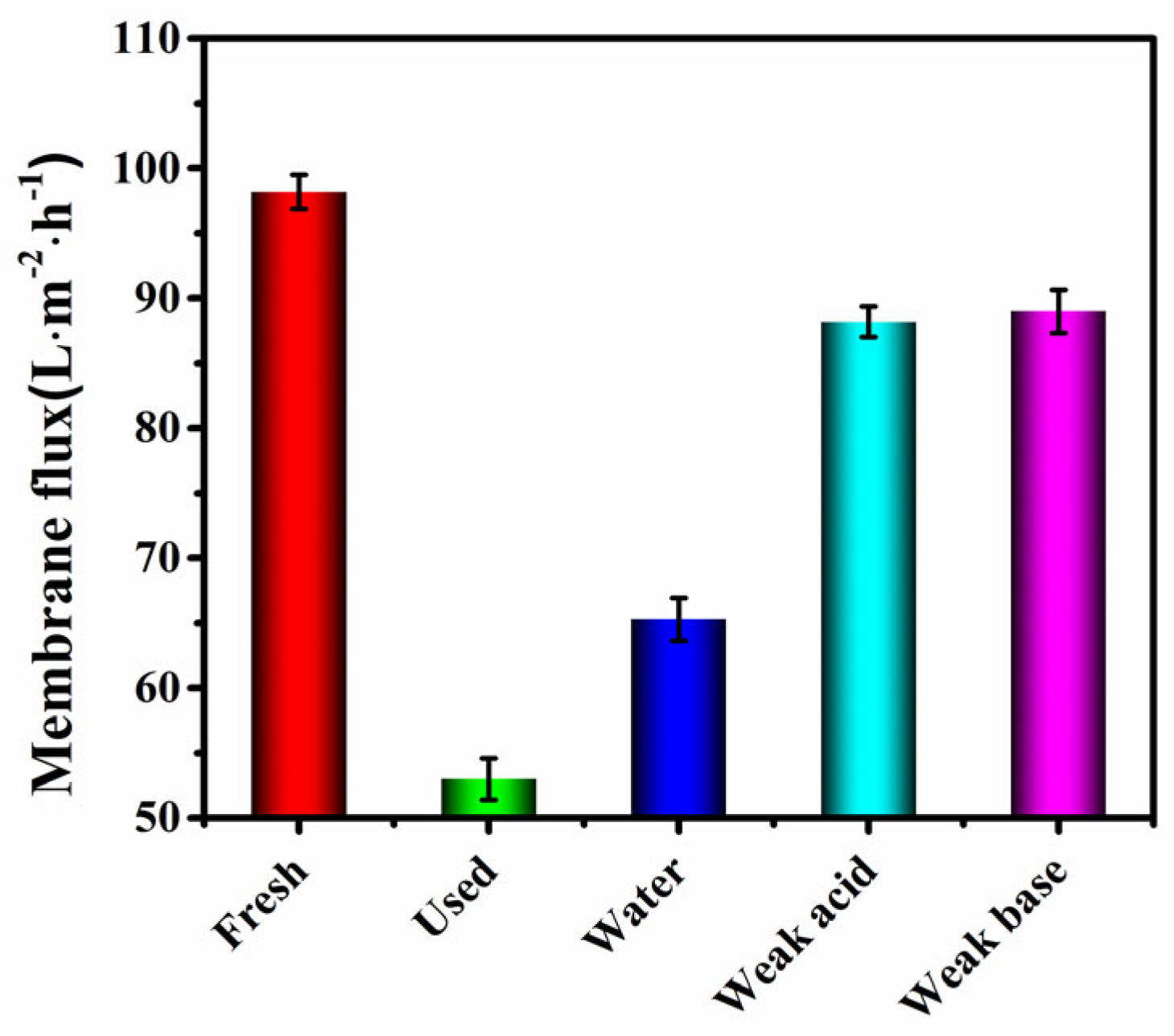
| Parameters | Values | Methods/Equipments |
|---|---|---|
| CODCr (mg·L−1) | 326~572 | Dichromate titration |
| NH3-N (mg·L−1) | 34.9~79 | Nasser’s reagent spectrophotometry |
| Turbidity (NTU) | 48~177 | Turbidity meter (WZB-182) |
| Pb2+ (mg·L−1) | 23–31 | Spectrophotometry |
| Temperature (°C) | 10~31 | Thermometer |
| pH | 6~9 | pH meter (PB-10) |
| DO (mg/L) | 1~6 | Dissolved oxygen analyzer (Polymetron 9582) |
| Sum of Square | DF | Mean Square | F-Value | p-Value | |
|---|---|---|---|---|---|
| Model | 3880.5 | 3 | 1293.5 | 151.7 | 0 |
| Error | 682.2 | 80 | 8.5 | ||
| Total | 4562.7 | 83 |
| Sum of Square | DF | Mean Square | F-Value | p-Value | |
|---|---|---|---|---|---|
| Model | 3029.8 | 3 | 1009.9 | 126.6 | 0 |
| Error | 638.1 | 80 | 8.0 | ||
| Total | 3667.9 | 83 |
| Sum of Square | DF | Mean Square | F-Value | p-Value | |
|---|---|---|---|---|---|
| Model | 6247.4 | 3 | 2082.5 | 220.8 | 0 |
| Error | 754.3 | 80 | 9.4 | ||
| Total | 7001.7 | 83 |
| Sum of Square | DF | Mean Square | F-Value | p-Value | |
|---|---|---|---|---|---|
| Model | 9986.9 | 3 | 3329.0 | 222.7 | 0 |
| Error | 1195.9 | 80 | 14.9 | ||
| Total | 11,182.8 | 83 |
| Pollutants | SU-SUG (Sig.) | UF-SUG (Sig.) | UF-SU (Sig.) | CT-SUG (Sig.) | CT-SU (Sig.) | CT-UF (Sig.) |
|---|---|---|---|---|---|---|
| CODcr | 1 | 1 | 0 | 1 | 1 | 1 |
| NH3-N | 1 | 1 | 1 | 1 | 1 | 1 |
| Turbidity | 1 | 1 | 1 | 1 | 1 | 1 |
| Pb2+ | 1 | 1 | 1 | 1 | 1 | 1 |
Disclaimer/Publisher’s Note: The statements, opinions and data contained in all publications are solely those of the individual author(s) and contributor(s) and not of MDPI and/or the editor(s). MDPI and/or the editor(s) disclaim responsibility for any injury to people or property resulting from any ideas, methods, instructions or products referred to in the content. |
© 2024 by the authors. Licensee MDPI, Basel, Switzerland. This article is an open access article distributed under the terms and conditions of the Creative Commons Attribution (CC BY) license (https://creativecommons.org/licenses/by/4.0/).
Share and Cite
Yang, F.; Pei, L.; Wang, Z.; Duo, J. Straw Biochar and Graphite Oxide Enhanced External Pressure Ultrafiltration for Leaded Wastewater Treatment. Toxics 2024, 12, 500. https://doi.org/10.3390/toxics12070500
Yang F, Pei L, Wang Z, Duo J. Straw Biochar and Graphite Oxide Enhanced External Pressure Ultrafiltration for Leaded Wastewater Treatment. Toxics. 2024; 12(7):500. https://doi.org/10.3390/toxics12070500
Chicago/Turabian StyleYang, Fan, Liang Pei, Zhenggang Wang, and Jia Duo. 2024. "Straw Biochar and Graphite Oxide Enhanced External Pressure Ultrafiltration for Leaded Wastewater Treatment" Toxics 12, no. 7: 500. https://doi.org/10.3390/toxics12070500
APA StyleYang, F., Pei, L., Wang, Z., & Duo, J. (2024). Straw Biochar and Graphite Oxide Enhanced External Pressure Ultrafiltration for Leaded Wastewater Treatment. Toxics, 12(7), 500. https://doi.org/10.3390/toxics12070500








